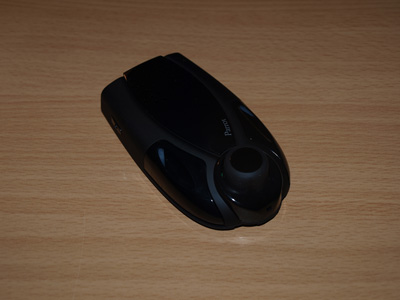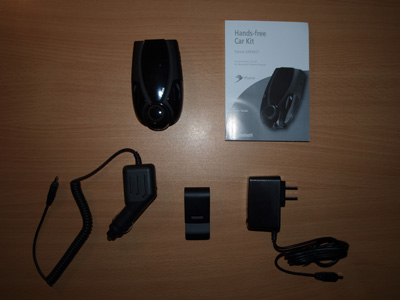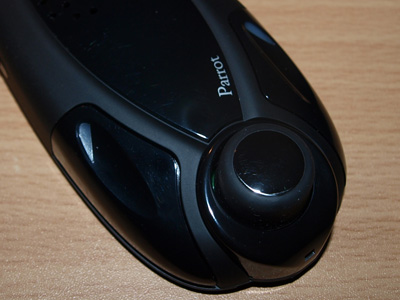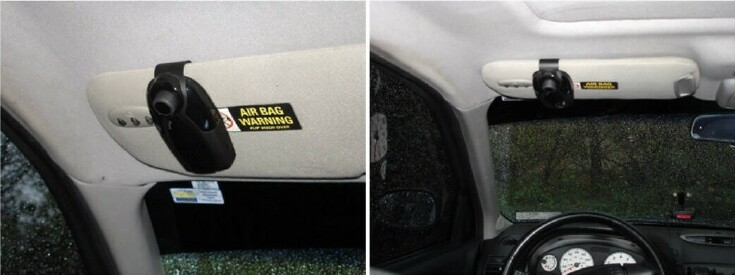What in the world did we do before Bluetooth? I mean, really. The thought of actually walking around or driving (or even sitting at my desk, anymore) and holding a phone to my head just seems archaic. Caveman-like. Ridiculous. And now that I have a voice-activated headset (the marvelous BlueAnt V1), I almost get annoyed when I have to actually dial a number. Yeah, I'm a little spoiled, but whatever.
So now I have the Parrot MINIKIT, a Bluetooth speakerphone with voice recognition. Parrot has a long line of Bluetooth products for use in the car, including several with LCD screens which require a hard installation of some sort or another. The MINIKIT, however, is a less-complicated, portable speakerphone that can be used in and out of the car.

The Parrot website lists the following as features of the MINIKIT:
- 3 button user interface
- 2W Hi-Fi speaker
- Omnidirectional microphone
- DSP-2 signal processing algorithms
- Built-in voice recognition software
- Pairing: up to five phones
- Recharging time: three hours maximum
- Talk time: 10 hours
- Standby time: over 275 hours
Design/Operation
The MINIKIT is packaged with the standard fare for such products: a car charger, an AC adapter, a visor clip and a thick, somewhat-intimidating user manual. Intimidating, that is, until you thumb through it and realize that it's actually localized into no less than 9 languages. There are actually only 15 pages of instructions for each language.

Instead of the traditional one-button approach to making and receiving calls, Parrot has gone with two separate buttons on the MINIKIT, with a green-lit button for answering calls and a red-lit button for ending/denying calls. I actually like having the two buttons a lot, as the interface directly mimics the approach used by just about every cell phone on the market today. With most other Bluetooth devices, you have to hold a button down or double-click a button to end or deny a call, where on the MINIKIT you just do what comes "naturally" and hit the red button.
The MINIKIT also uses a dial to control the volume of the call, as opposed to the and – buttons used by most of the similar devices I've seen and used. The dial, located prominently on the top-front of the MINIKIT, makes for much easier adjustment of the volume when you're in the car, assumedly paying attention to other stuff like cars, trucks, pedestrians and what not.

The MINIKIT itself is rather large, compared with other speakerphones I've seen, and that's actually not such a bad thing. I find it pretty easy to lose small things between the seats and in other nooks and crannies in the car. I live in the city and usually don't like to leave devices out in the open to tempt thieves, so I'm constantly taking my speakerphones and radar detector and faceplate and such in and out of the car. Also, the larger device also allows for larger buttons and the big volume knob, so it's easier to reach and find the appropriate button when your eyes are on the road. There also must be a rather large battery in there, as Parrot lists 10 hours' talk time and over a week of standby time. The MINIKIT also uses mini-USB to charge the device, and any mini-USB cable will work.

Operation/Voice recognition
To make a call, you can use the traditional method of using the phone to find a contact and/or dial a number, or you can use the voice recognition feature. The voice recognition feature is very, very effective if your phone is capable of sending contacts via Bluetooth and you have it set up properly. (A side note to save Windows Mobile users a TON of frustration here: in order to send contacts through Bluetooth, you have to go to Settings; Connections; Beam and enable the Receive all incoming beams setting to send contacts. It took me forever to figure this insanely obscure and poorly-named setting and realize that it was keeping me from sending contacts to the MINIKIT. This was almost a very different review, to no fault of the MINIKIT.)
The process of recording all of the necessary voice functions and sending the contact information is cumbersome at first, but once you get started it goes by pretty quickly. To make a long story short, you have to Bluetooth (is this a verb? I'm going for it) the contacts from your phone to the MINIKIT, and then record the name tag for the contact by saying the name of the person twice when prompted. Personally, I had never seen a setup like this. I have 2 other voice activated devices, and with one you actually have to read the numbers for each contact into the phone, which is horrible, and the other (the BlueAnt V1, discussed here) uses the speed dial settings in your phone to dial numbers. The MINIKIT contact setup is by far the best I have used, as when you send the contact via Bluetooth, all of the phone numbers associated with that contact are now in the MINIKITÂ’s memory. When you activate a contact, you are also given the option to designate which of the contact's numbers you want to dial (general, home, cellular or work). And yes, that is very cool.
Also cool is that when you receive a call from one of your programmed contacts, the MINIKIT will recognize the caller ID and actually read your recorded name tag back after playing the ringtone. This is extremely cool. On most Bluetooth devices, youÂ’re lucky if the thing reads off the phone number to you when a phone call comes in, and luckier yet if you actually recognize the number. The MINIKIT will, in effect, tell you who the caller is with the sound of your own voice. This is great for when you get a call and you want to know who the caller is without having to dig your phone out of your pocket or briefcase or whatever else. Obviously, this only works for the contacts you have programmed into the MINIKIT, but thatÂ’s better than nothing.
Now, the problem with this whole "sending contact info via Bluetooth" thing is that if your phone doesn't support this feature, you won't be able to use the voice recognition at all. There is no alternative method for programming the thing, so you might want to make sure your phone is compatible before picking one of these up. The compatibility chart on the website is terribly out of date (the "palmOne" section lists four Treos, the 650, 680, 700wx and 750v), but I was able to get it to work on my Treo Pro (after the making the setting listed above) and I'm pretty sure it will work on PalmOS Treos and Centros as well.
One thing that rankled me quite a bit about operating the MINIKIT was the ridiculous menu setup. I won't go into specifics about how it works, but it was really, really annoying at first. For example, the MINIKIT does not have English setup as the default language, and the default volume was very low. It took me an embarrassing amount of time to realize that the doggone thing wasnÂ’t even speaking English (the instructions say that the device is supposed to be able to determine a language setting by the initial pairing with your phone, but it sure didnÂ’t work for me). So I had to make 2 separate menu adjustments before I could really get started, and the button press/menu selection arrangement is sooooo horrifically frustrating I wanted to stomp my MINIKIT into pieces. But I eventually got the hang of it and was able to make it all work.
All that being said, once you have the MINIKIT properly programmed, the voice recognition feature works very, very well. The device did a very good job of picking up my voice commands, even in the car. You just press the green button, say the name of one of your programmed contacts, tell the device which number you want to call (or, if you don't specify a number, the unit will dial the home number by default if there are several; if there is only one number for the contact the MINIKIT will call that one) and your call is placed. It was very rare that the MINIKIT didnÂ’t recognize what I said.
The sound quality and volume was also very good. Callers rarely noticed any difference in my voice, and I could hear the other side loud and clear.
Conclusion
All things considered, the Parrot MINIKIT is one heckuva speakerphone. Even though it can be quite a pain to get used to the setup features, the device works very well once you get it going. And hey: it's only $79.95, so itÂ’s definitely a good deal considering all of the functionality.
|
|
| Pros |
Very good sound quality
Capable voice activation
Green and red buttons
Mini-usb charging connection
|
|
| Cons |
Menu setup is annoying
Voice recognition requires ability to send contacts via Bluetooth
Bulky |
|